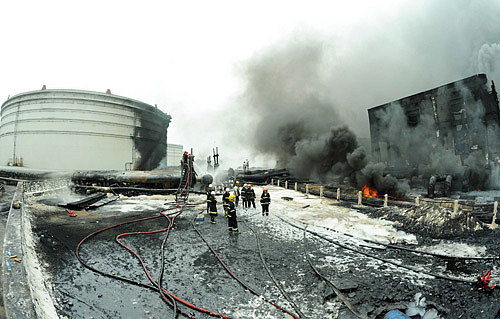|
 |
|
VICTORY IS CLOSE: On July 17, firefighters try to extinguish fires caused by oil pipeline blasts the previous day at Xingang Port in Dalian (LI GANG) |
Two weeks after an oil pipeline explosion on July 16 in Dalian, northeast China's Liaoning Province, the coastal city is still trying to minimize the ecological impact on the environment and boost local tourism, aquatic farms and fisheries out of its shadow. The accident resulted in the leak of 1,500 tons of oil into the sea.
Fire engulfed the Xingang Port after the explosion of two pipelines attached to an oil storage tank. The pipelines damaged by the blasts are property of a joint venture between PetroChina International Co., a unit of PetroChina, and Dalian Port Co. Ltd. PetroChina is the listed unit of China National Petroleum Corp. (CNPC), China's largest oil company. The fire raged for about 15 hours before being extinguished the next day. No one was injured.
On July 18, oil slicks, the thickest being 1 meter, were seen in the water near Xingang Port and the longest oil belt on the sea surface measured 18 km. The monitoring data of the State Oceanic Administration showed that 430 square km of the sea was polluted at 1:30 p.m. on July 19, of which 12 square km were under severe pollution.
A massive cleanup operation was launched the day after the explosion. At a press conference on July 26, Dai Yulin, Vice Mayor of Dalian, said the majority of the oil spilled into the sea was mopped up after one week's cleanup effort and his city has stopped the oil spill from reaching international waters.
The cleanup has involved 266 trips of oil-skimming vessels and 8,150 trips of fishing boats, Dai told reporters. Maritime agencies and oil companies have laid down more than 40,000 meters of oil barriers and 65 tons of oil absorbent mats.
"But the next stage, which is clearing it up, is an arduous task," Dai told the press briefing. He said starting July 26 the cleanup operation would shift from the offshore areas to Dalian's coast, which will be cleaned "meter by meter and inch by inch."
CNPC General Manager Jiang Jiemin, who arrived at Dalian on July 18 to oversee the company's cleanup work, said his company has tightened safety measures at all of its facilities and will complete the cleanup of the slick as soon as possible.
As the waterways affected by the oil have been basically cleared, authorities lifted a partial ban on maritime traffic at some ports in Dalian on July 20. The Maritime Affairs Administration of Liaoning Province said ports in Dalian had been fully re-opened as of 5 p.m.
Oil shipments from Dalian, which lies at the heart of northeast China's crude oil production base and is a major port for China's crude oil imports, have been vital to the country's oil production and consumption. After the blasts and the leak, south China refineries scaled back operations due to petroleum supply shortages while at least three CNPC subsidiaries reduced sales of refined oil in southern provinces, according to a Xinhua report on July 20.
CNPC said on July 22 that the pipeline connecting Xingang Port and its Dalian Petrochemicals, damaged by the explosion, had been repaired and resumed normal operations. On July 29, Xingang Port resumed full operations, nearly two weeks after the oil spill. A 300,000-ton oil tanker began unloading crude oil at about 11 a.m. July 29, marking the full restoration of port services.
The tanker and oil pipelines were inspected for safety before the oil was unloaded. The oil dock was the last facility to resume full operations. The harbor received more than 130 tankers and ships between July 27 and 29.
The State Administration of Work Safety and the Ministry of Public Security released the results of a joint investigation on July 23, concluding that improper desulfurizing injections into the oil pipeline caused its explosion.
According to the investigation report, on July 15, a 300,000-ton tanker started to unload its oil into an onshore storage tank and workers from Shanghai-based Q.PRO Inspection and Technical Service Co. and Tianjin-based Huishengda Petroleum Technology Co. started to inject desulfurizer into a tank through a pipeline. At around 1 p.m. the next day, the unloading was suspended while the injection of desulfurizer, which should have also stopped, continued. At around 6 p.m., the first explosion took place, causing a major fire and the oil spill.
| 